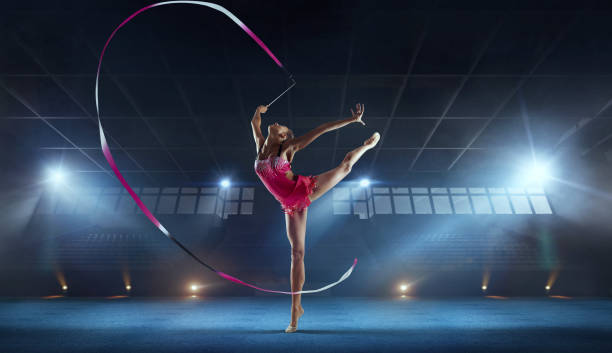Rhythmic Gymnastics: The Artistic Evolution of Sport and Dance
In the vibrant world of competitive sports, rhythmic gymnastics stands out as a mesmerizing blend of athleticism, artistry, and grace. This captivating discipline pushes the boundaries of human flexibility, coordination, and creativity, challenging athletes to perform intricate routines with ribbons, hoops, balls, clubs, and ropes. As we delve into the fascinating realm of rhythmic gymnastics, we'll explore its rich history, unique challenges, and the incredible skill set required to excel in this demanding sport.

In the early 1900s, Émile Jaques-Dalcroze, a Swiss composer and music educator, created a system of musical education called Eurhythmics. This method emphasized the connection between music and movement, laying the groundwork for the rhythmic aspect of gymnastics. Simultaneously, Isadora Duncan, an American dancer, was revolutionizing the dance world with her free-flowing, expressive style that rejected the rigid constraints of classical ballet.
These innovative approaches to movement and expression converged in the 1920s and 1930s, giving rise to what would eventually become rhythmic gymnastics. The sport began to take shape in the Soviet Union, where it was initially known as “artistic gymnastics.” It gained popularity across Eastern Europe and was recognized by the International Gymnastics Federation (FIG) in 1961.
The Evolution of Apparatus and Techniques
As rhythmic gymnastics evolved, so did the apparatus used in competitions. Initially, the sport focused on free-hand exercises and simple props like tambourines and scarves. However, as the discipline matured, more sophisticated equipment was introduced to challenge athletes and enhance the visual spectacle of performances.
The five apparatus now central to rhythmic gymnastics each bring unique challenges and opportunities for artistic expression:
- Ribbon: Introduced in the 1960s, the ribbon allows for fluid, sweeping movements and intricate patterns in the air. Mastering the ribbon requires exceptional hand-eye coordination and spatial awareness.
- Hoop: One of the earliest apparatus, the hoop enables gymnasts to create dynamic shapes and perform impressive throws and catches. It demands precision and control to maintain its circular shape during complex maneuvers.
- Ball: The ball highlights a gymnast’s ability to perform smooth, continuous movements. It requires a delicate touch to balance, roll, and bounce the ball while maintaining grace and fluidity.
- Clubs: These apparatus test a gymnast’s dexterity and timing. Juggling and swinging the clubs in perfect synchronization with the music demands intense focus and skill.
- Rope: While no longer used in senior-level individual competitions, the rope remains a staple in group routines and junior competitions. It showcases a gymnast’s jumping ability and coordination.
The techniques used in rhythmic gymnastics have also evolved significantly. Early routines were relatively simple, focusing on basic dance movements and simple manipulations of the apparatus. Today’s elite gymnasts perform jaw-dropping feats of flexibility, balance, and coordination, seamlessly blending elements of ballet, modern dance, and acrobatics with highly technical apparatus work.
The Physical and Mental Demands of Rhythmic Gymnastics
Rhythmic gymnastics is one of the most physically demanding sports in the world, requiring a unique combination of strength, flexibility, coordination, and endurance. Gymnasts must develop and maintain exceptional levels of these physical attributes to perform their routines with precision and grace.
Flexibility is perhaps the most visually striking aspect of rhythmic gymnastics. Athletes regularly perform splits, backbends, and contortions that seem to defy the limits of human anatomy. This extreme flexibility is the result of years of intense stretching and conditioning, often beginning at a very young age.
Core strength is crucial for maintaining balance and control during complex movements and apparatus manipulations. Gymnasts develop incredible abdominal and back muscles through targeted exercises and countless repetitions of their routines.
Cardiovascular endurance is essential for performing high-intensity routines that can last up to two and a half minutes. Athletes must maintain their energy and precision throughout the entire performance, executing difficult elements with the same level of control at the end of the routine as at the beginning.
The mental demands of rhythmic gymnastics are equally challenging. Gymnasts must memorize and perfectly execute intricate routines, maintaining absolute focus and concentration throughout their performance. The pressure of competition can be intense, with years of training culminating in a single, brief routine that can make or break an athlete’s aspirations.
The Artistic Element: Music, Choreography, and Expression
What sets rhythmic gymnastics apart from many other sports is its emphasis on artistic expression. Each routine is a carefully choreographed performance set to music, requiring gymnasts to embody the character and emotion of their chosen theme.
Music selection is a crucial aspect of routine development. Gymnasts and their coaches spend considerable time choosing music that complements their strengths and allows for a dynamic and engaging performance. The music must inspire both the athlete and the audience, providing a backdrop for the gymnast’s physical prowess and emotional expression.
Choreography in rhythmic gymnastics is a complex art form in itself. Routines must seamlessly blend required technical elements with artistic movements that interpret the music and convey a story or emotion. Choreographers work closely with gymnasts to create routines that showcase their individual strengths and personalities while meeting the strict requirements of international competition.
The expressive aspect of rhythmic gymnastics is what truly elevates it from a mere display of physical skill to a captivating art form. Gymnasts must use their entire body, including facial expressions, to convey emotion and connect with the audience and judges. This requires not only physical control but also a deep understanding of performance and the ability to project confidence and charisma under pressure.
Judging and Scoring: Balancing Technicality and Artistry
The scoring system in rhythmic gymnastics has evolved significantly over the years, reflecting the sport’s increasing complexity and the desire to balance technical difficulty with artistic merit. The current scoring system, implemented by the FIG, aims to provide a comprehensive evaluation of each routine.
Routines are judged on two main components: Difficulty (D) and Execution (E). The Difficulty score assesses the technical content of the routine, including the complexity of apparatus handling, body movements, and dance steps. Judges evaluate the variety and difficulty of elements performed, with more challenging skills earning higher scores.
The Execution score starts from a perfect 10 and deducts points for any errors or imperfections in the performance. This includes technical mistakes such as dropping the apparatus or losing balance, as well as artistic shortcomings like lack of expressiveness or poor synchronization with the music.
In addition to these primary components, judges also consider the overall artistic impression of the routine. This includes factors such as the originality of the choreography, the gymnast’s ability to interpret the music, and the overall coherence and impact of the performance.
The challenge for gymnasts and coaches is to create routines that maximize difficulty scores while maintaining flawless execution and artistic appeal. This delicate balance is what makes rhythmic gymnastics such a complex and fascinating sport to both perform and watch.
The Global Reach of Rhythmic Gymnastics
While rhythmic gymnastics originated in Eastern Europe, it has grown into a truly global sport. The International Gymnastics Federation recognizes over 140 national federations, showcasing the worldwide appeal of this unique discipline.
However, the sport’s competitive landscape remains dominated by a handful of countries with strong gymnastics traditions. Russia has long been the powerhouse of rhythmic gymnastics, producing numerous Olympic and World champions. Other countries with strong programs include Belarus, Ukraine, Bulgaria, and Italy.
In recent years, there has been a concerted effort to expand the reach of rhythmic gymnastics to new regions. Countries like Japan, South Korea, and the United States have made significant strides in developing competitive programs, bringing fresh perspectives and diverse cultural influences to the sport.
The inclusion of rhythmic gymnastics in the Olympic Games since 1984 has been crucial in raising its global profile. The Olympic competition, featuring both individual and group events, is considered the pinnacle of the sport and has helped introduce rhythmic gymnastics to audiences worldwide.
Challenges and Controversies in Rhythmic Gymnastics
Like many elite sports, rhythmic gymnastics faces its share of challenges and controversies. One of the most pressing issues is the intense physical demands placed on young athletes. The sport’s emphasis on extreme flexibility and the aesthetic ideal of a lean physique has raised concerns about the long-term health impacts on gymnasts, particularly those who begin intensive training at a very young age.
There have been ongoing discussions within the gymnastics community about raising the minimum age for senior-level competition to protect young athletes from excessive physical and psychological pressure. Currently, gymnasts must be at least 16 years old to compete at the senior level in international competitions, but many begin their serious training much earlier.
Another challenge is the subjective nature of judging in rhythmic gymnastics. While the current scoring system aims to provide objective criteria for evaluation, there is still significant room for interpretation, particularly in the artistic components of routines. This can lead to controversies and disagreements over scoring, especially in high-stakes competitions.
The sport also grapples with issues of diversity and inclusivity. Historically, rhythmic gymnastics has been dominated by athletes from Eastern Europe, and there have been calls for greater efforts to develop the sport in underrepresented regions and communities.
The Future of Rhythmic Gymnastics
As rhythmic gymnastics continues to evolve, several trends and developments are shaping its future:
- Technological Integration: Advanced motion capture technology and video analysis tools are being used to help gymnasts refine their techniques and prevent injuries. There’s also potential for incorporating these technologies into judging to provide more objective assessments of performances.
- Increased Athleticism: The physical demands of the sport continue to increase, with gymnasts pushing the boundaries of what’s possible in terms of flexibility, strength, and apparatus handling. Future routines are likely to feature even more complex and spectacular elements.
- Artistic Innovation: Choreographers and gymnasts are constantly seeking new ways to interpret music and express emotions through movement. We can expect to see increasingly creative and diverse artistic approaches in future competitions.
- Expanding Global Reach: Efforts to popularize rhythmic gymnastics in new regions are likely to continue, potentially bringing fresh perspectives and styles to the sport.
- Focus on Athlete Well-being: There’s a growing emphasis on ensuring the long-term health and well-being of gymnasts, which may lead to changes in training methods and competition structures.
- Male Participation: While rhythmic gymnastics is currently a female-only sport at the Olympic level, there’s increasing interest in developing men’s rhythmic gymnastics, which could potentially become a recognized discipline in the future.
The Enduring Appeal of Rhythmic Gymnastics
Rhythmic gymnastics occupies a unique space in the world of sports, blending athletic prowess with artistic expression in a way that few other disciplines can match. It challenges athletes to push the boundaries of human physical capability while maintaining grace, poise, and emotional connection with their audience.
For spectators, rhythmic gymnastics offers a mesmerizing display of skill, creativity, and beauty. Each routine tells a story, inviting the audience to experience a range of emotions through the gymnast’s movements and expressions. The harmony between athlete, apparatus, and music creates a captivating spectacle that can be appreciated on multiple levels, from the technical complexity of the movements to the overall artistic impact of the performance.
The sport also holds valuable lessons that extend beyond the competition floor. The dedication, discipline, and perseverance required to excel in rhythmic gymnastics can inspire individuals in all walks of life. The emphasis on combining physical skill with artistic expression encourages a holistic approach to personal development, valuing both athletic achievement and creative growth.
As rhythmic gymnastics continues to evolve, it will undoubtedly face challenges and undergo changes. However, its core appeal – the seamless blend of athleticism and artistry – remains as compelling as ever. Whether performed on the Olympic stage or in local gymnasiums, rhythmic gymnastics will continue to inspire, challenge, and captivate athletes and audiences alike, showcasing the incredible potential of the human body and spirit.
In conclusion, rhythmic gymnastics stands as a testament to the endless possibilities that arise when sport and art converge. It pushes the boundaries of human physical capability while celebrating the beauty of movement and expression. As we look to the future, rhythmic gymnastics will undoubtedly continue to evolve, inspiring new generations of athletes and audiences with its unique blend of strength, grace, and creativity. The journey of this remarkable sport, from its humble beginnings to its current status as an Olympic discipline, is a fascinating story of human innovation and artistic vision – one that continues to unfold with each passing competition and each new generation of gymnasts who dedicate themselves to mastering this extraordinary art form.





